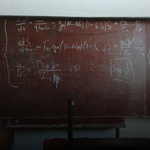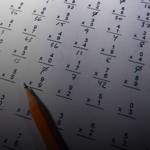Section 1
Preview this deck
removable discontinuity
Front
Active users
0
All-time users
0
Favorites
0
Last updated
5 years ago
Date created
Mar 1, 2020
Cards (60)
Section 1
(50 cards)
removable discontinuity
(b-a)/n
change in x equals this
maximum value
a function has this at C if f(c)>f(x) for all x in the domain of of f
local max or min
always there on an open interval except on a line
L(x)=f(a)+f'(a)(x-a)
equation for linear approximation
-sinx
derivative of cosx
integrals
if f is a function defined where f(x)>0 for a<x<b, divide the interval [a,b] into subinterval of equal width let x-initial=a, xsub1, xsub2.....=b are the end points of the subinterval. the definite one of f from a to b. represents area under the curve
average velocity
displacement over change in time
l'hostpital's rule
suppose f and g are differentiable and g'(x) doesn't equal 0 on an open interval I that contains a (except possibly at A) then limf/g as x approaches a=limf'/g' as x approaches a
RlnM
what lnM^R is equivalent to
number of divisions under the curve
n= this
mean value theorum
let f be a function that satisfies the following hypothesis: fi is continuous on the closed interval [a,b]. f is differentiable on the open interval (a,b). then there is a number, C, on (a,b) so that f'(c)=f(b)-f(a)/b-a
intermediate value theorum
suppose that f is continuous on the closed interval [a,b] and let N be any number between f(a) and f(b) where f(a) doesn't equal f(b). then there exists a number, C, in [a,b] such that f(c)=N
concavity
what the second derivative test checks for
sec^2(x)
derivative of tanx
infinite discontinuity
continuous function
f(x) is defined at a. limf(x) exists. limf(x)=f(a)
cosx
derivative of sinx
squeeze theorum
if f(x)<g(x)<h(x) when x is near A (but not A) and limf(x)=limh(x)=L then limg(x)=L
(f(x+h)-f(x))/h
instantaneous rate of change
1/x
derivative of lnx
local max and mins
what the first derivative test checks for
removable discontinuity
Rolle's theorum
let f be a function that satisfies the following hypothesis: f is continuous on the closed interval [a,b]. f is differentiable on the open interval (a,b). f(a)=f(b) then there is a number c in (a,b) such that f'(c)=0
net change theorum
interal of F'(x)dx=F(b)-F(a)
1/(1-x^2)^(1/2)
derivative of sin^-1(x)
-cscxcotx
derivative of cscx
fundamental theorum of calculus Pt. 1
if g(x)=the integral from a-x of f(t)dt then g'(x)=f(x)
extreme value theorum
if f is contunous on a closed interval [a,b] then f attains an absolute max value f(c) and an absolute min value f(d) at some c and d in the interval [a,b]
1/xlna
derivative of dlogx
-cscx
derivative of cotx
-1/(1-x^2)^(1/2)
derivative of cos^-1(x)
f'(x)/g'(x)
derivative of lnf(x)
newton's method
if x-initial is an initial approximation to f(x)=0 then x sub (n+1) = f(xsubn)/f'(xsubn)
jump discontinuity
secxtanx
derivative of secx
lnM-lnN
what lnM/N is equivalent to
limit of a function
suppose f(x) is defined when x is near A (in an open interval that contains A but not neccessarily at A)
chain rule
f'=f'(g(x))g'(x)
lnM+lnN
what lnM*N is equivalent to
vertical asymptote
limx-->af(x)=+-infinity then A is this
1/|x|(x^2-1)^(1/2)
derivative of sec^-1(x)
marginal cost
cost to produce the next item
antiderivative theorum
if F is an antiderivative of f on an interval I, then the most general antiderivative of f on I is F(x)+C (where C is an arbitrary constant)
antiderivative definition
F(x) is an antiderivative of f(x) on an interval I if F'(x)=f(x) for all x's in I
1.) find derivative and set it equal to zero to find the critical numbers ON THE INTERVAL 2.) find values of the end points and critical points 3.) find the biggest and smallest ones ON THE INTERVAL
steps to find absolute max and mins
minimum value
a function has this at c if f(c)<f(x) for all x in the domain of f
horizontal asymptote
if the limf(x)=L as x goes to positive or negative infinity then y=L
fermat's theorum
if f has a local max or min at c and if f'(c) exists then f'(c)=0. a critical number of a function is a numbeer c in the domain of f such that f'(x)=0 or f'(x) doesn't equal 0
1/1+x^2
derivative of tan^-1(x)
Section 2
(10 cards)



